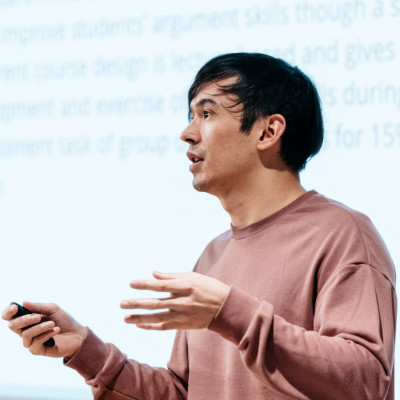Sessions / Show & Tell presentation
ESL Speed Readings: the app #3091
Speed reading is an important skill for language learning. It falls into Paul Nation's fluency strand of language learning. Speed reading is considered a fluency activity because there should be no unknown vocabulary, or at least very little, in the readings. With an understanding all of the words, learners can focus on increasing their reading speed, instead of slowing down to guess the meaning of unknown vocabulary. At the English Language Institute, Victoria University of Wellington, teachers have been incorporating speeding reading for years. Over the years, Sonia Millett, Paul Nation, and Emmy Quinn have written over 100 stories for the speed reading component at the Institute. Each of these stories has a comprehension quiz which consists of 10 multiple-choice questions. Until recently, these stories were only available in PDF format. This presentation introduces the newest format for the speed readings. The speed readings have been used to create a mobile app titled 'ESL Speed Readings'. This is a free app and is available for Android and iOS devices. The app comes with 100 stories at four different graded levels. The app takes care of the entire speed reading process, including automatic quiz scoring and data visualization. By doing so, learners can focus on increasing their reading speed without worrying about writing down their reading time or grading their own quizzes. Additionally, the app uses standard words per minute, has a reading timer that is accurate to 0.4 words, and provides frequent customized feedback to the learner based on their past performance. The presenter, who is the developer of the app, will demonstrate the app, detail its mechanics, discuss implications for research and pedagogy, and highlight future updates.
Exploring the role of interactive fiction creation on writing motivation #3077
Motivating our students to write in English can be challenging. This presentation will describe a Project Based Learning (PBL) task focused on student-made interactive fiction (also called gamebooks) using Google Slides. The findings of a case study conducted with 48 first-year university students showing increases in time-on-task, engagement, and motivation will be discussed. In particular, it was found that students' motivation to write in English greatly increased as a result of the project. As well, the presenter will explain the creative process of organizing a gamebook using storyboards and flowcharts (which can be created offline) and the benefits of using Google Slides to facilitate collaboration and content sharing. This presentation will be of particular interest to language educators looking for a creative way to motivate students to produce meaningful and enjoyable English compositions.
A new extensive speaking tool for Moodle #2934
This presentation will introduce a new extensive speaking tool for Moodle that can translate and score student speech. The tool is intended to provide translation and pronunciation support for lower-level language learners. When learners are engaged in speaking tasks, they often process their ideas in the L1, causing fluency issues with L2 production. In order to improve forward momentum with speaking tasks, a new speaking tool is being developed that allows a learner to speak a phrase or sentence in their L1, listen to a translation of the phrase or sentence in the L2, and practice speaking the language in the L2. This tool enables students to assemble a database of new L2 words and phrases over time. To use the tool, learners speak into the microphone using their L1, and listen to a spoken translation of their L1 phrase. Their spoken utterance is then automatically scored based on how well the student is able to speak the new word or phrase. Learners have the opportunity to listen to the pronunciation of new words or phrases used in a specific context, and can practice their production skills as they repeat the language in the L2. Practice language tasks or language tests can be generated based on the database of items generated by a learner or an entire class. The Moodle plugin, developed by the presenter, can be used as a teaching tool to identify language items that students need to review.
Nation’s Four Strands and Digital Language Pedagogy with ZenGengo #3255
In recent years, the move toward blended and hybrid forms of language learning has lead many teachers to re-evaluate their digital toolsets. Language teachers in particular need not only a reliable set of tools but also a solid pedagogical framework within which these tools can be put to use. As the old saying goes – it’s not just the technology, but what you do with it that counts.
Renowned linguist Paul Nation argues that a well-balanced language course should consist of four strands: meaning-focused input, meaning-focused output, language-focused learning, and fluency development (Nation, 2007).
In this presentation, the developer of ZenGengo, a web-based language teaching and learning platform, will demonstrate how the platform can be used to quickly and easily create activities that correspond with each of Nation’s four strands.
The presenter will show how by using ZenGengo, language teachers can not only create more effective and engaging activities for their learners, but also manage their own workloads more efficiently, and ensure that students can always access their course materials whether face-to-face, fully online, or somewhere in between.
Nation, P. (2007). The four strands. International Journal of Innovation in Language Learning and Teaching, 1(1), 2-13.
Collaborative Video Project on Japanese Culture and Zoom Presentation via Flipgrid #3079
The rapid development and increased availability of ICT tools have provided both learners and teachers with new insights and challenges into language learning and teaching. By using ICT tools in education, so many research results in Technology-Enhanced Language Learning (TELL) have shown that TELL is an effective approach that helps students and teachers to achieve certain educational goals while creating great opportunities for collaborative interaction, situated learning, and support for learning outside formal contexts. As a TELL practitioner, the presenter has actively used a variety of digital tools and free online resources for both EFL teaching and general education seminars in a hybrid style. In this presentation, I will discuss the pros and cons of individual (short-term) or small-group (semester-long) collaborative video projects. The project content engaged learners in thinking about Japanese culture, with a focus on snacks and/or drinks. Tools used included Zoom presentations, Flipgrid and Google Forms during the 2020-2021 academic years. I will share my experiences of implementing these tools in and beyond the classroom context. I will share data from post-project questionnaires and student work in the form of videos that were chosen from the final products in 2020-2021 classes. These videos will be used as examples of the positive and negative aspects of this video project. I will also clarify the reason why this project was largely unsuccessful and propose a possible solution for future implementation.
Making Life Easy With One Master Spreadsheet #2940
This practically-oriented presentation will demonstrate how to resolve the following matters using one spreadsheet to keep everything a teacher might need available within less than three clicks:
Language teachers often teach two or more sequential classes. Their students often have to quickly go to another lecture too. There are a few golden moments in between where a one-to-one exchange is possible for questions and communication. Such exchanges usually involve inquiries about given assignments or prior grades. Without an easy and timely way to answer such queries—all the while preparing for the next class—simple questions can become stressful for all concerned.
Participants in this session should have a good idea how to use a spreadsheet to record everything a university lecturer needs in one place, especially (1) student attendance, (2) grades & assignments.
Games and learning theory: An undergraduate course #3084
Games provide an accessible way to introduce learning theories (operant conditioning, sociocultural theory, etc.) in my undergraduate seminar titled “Games for learning.” Students play games in English and discuss how learning theory can explain them. For example, Kahoot is used to demonstrate operant conditioning, and Spaceteam ESL is used to demonstrate sociocultural theory. Students also develop and report on their own digital or analog games based on learning theories. Students have used Twine, Google Forms, and Unity to create their games. In this presentation, I describe the seminar and share examples of projects, games, and student work. I also describe how a collaboration with an overseas university was integrated into the course and explain lessons learned from this experience. Finally, I detail how I plan to develop the course in the future by emphasizing learner autonomy.
An Open Table for Using Dungeons & Dragons with University EFL Students at a Foreign Language Resource Center #2944
Tabletop role-playing games (TTRGPs) are growing in importance to the culture of the English-speaking world. 2022 marks the 10th year since the 5th edition of Dungeons & Dragons was introduced, with the game's growth and profitability soaring to record heights at a point when most TTRPGs would have reached market saturation and the end of its commercial viability (Abadia, 2021a). This record success has encouraged Hasbro to push Dungeons & Dragons further into the entertainment space (Abadia, 2021b), resulting in representations of Dungeons & Dragons in TV (Lawrence, 2021), movies (Ashton, 2021), and video games (Wilde, 2021). Given the continuing media saturation of Dungeons & Dragons into the English-speaking world, teaching the language and culture of TTRPGs is increasing in importance as a worthwhile area of language teaching. In addition, the shared storytelling nature of Dungeons & Dragons naturally lends itself to positive relationship building (Shea, 2019) through creating an environment requiring communication, a necessary component for language acquisition (Long, 1981). In this Show & Tell presentation, the presenter will describe the process of creating a Dungeons & Dragons tabletop role-playing game club at the Global Education Research Center of a large university in Tokyo. After briefly covering how the game of Dungeons & Dragons has become more prevalent in the English-speaking culture, the presenter will describe the principles used to orient the club as a language learning environment: namely, the after-school enrichment program model of education and open-table design principles (Alexander, 2011, 2016a, 2016b, 2016c). Following this, the presenter will outline the online resources, including blogs, podcasts, and videos that inspired the club's structure and content. Next, the presenter will describe the process of navigating the administration structure of the resource center. Finally, the presenter will describe the reactions of the students who attend.
Quiz Students on Words and Phrases with the Lingolab Sites #3067
In this presentation there will be interactive demonstrations of the three free LingoLab web apps. The LingoLab activity itself involves learners being shown a text/audio/picture prompt and learners respond by forming the target word or phrase in one of three response modes with differing levels of productive ability required: ‘Shown words’ mode, ‘Hidden letters’ mode, and ‘Stellar speller’ mode. Attendees of this session will learn how they can use the lingoLab activity to provide their students with word and phrase-level practice in the following sites: a) www.lingolab.co (for self-study practice with progress tracking & sharing functions); b) www.lingolab.online (for a one-time quiz which reports all results to a teacher); c) www.lingolab.live (for an in-class real-time multiplayer quiz game).
Promoting student interaction through Zoom polls #2946
A key challenge of synchronous hybrid instruction is finding ways to bridge the participation gap between face-to-face and online learners. What can be done to maintain a community of learners and promote accountability? How can all learners participate actively and have a voice in their learning? One tool built into the interface many of us have been teaching with is Zoom’s polling function. This talk will discuss how regularly employing Zoom polls at various lesson stages improves student engagement and allows the instructor to make real-time adjustments based on polling results. The following examples of Zoom polling uses will be demonstrated: check in/ exit questions, comprehension checking, peer assessment of presentations, and action-research surveys. Attendees will walk away with tangible examples of how Zoom polling can make classes more participatory, democratic, and engaging.
Creating an Online Archive of Digital-Keyword-Method Images #3065
A truism that every second-language learner knows is that without vocabulary, nothing else really matters (Tight, 2010). A common method, especially in Japan, for studying vocabulary is rote-repetition. This technique entails writing words over and over again in the hope that they will be consolidated into long-term memory. This is the opposite of fun. But there is a better, and more playful, way to learn vocabulary.
This Show & Tell presentation consists of three parts. First, a mnemonic technique for remembering vocabulary called the Keyword Method (Atkinson, 1975) will be introduced. The Keyword Method aims to create a link between the L2 word and its L1 meaning by using a “keyword” that sounds like the L2 word interacting with the L1 translation. In stark contrast to rote-repetition, the Keyword Method allows students to use their imagination and sense of fun to remember vocabulary. The next part of the presentation will explain how modern technology such as iPads, WiFi, Google images and Instagram was used to extend the original Keyword Method in a digital classroom. Finally, participants will be guided through a free online archive created by the presenter of over 650 modal-ensemble Digital-Keyword-Method images for more than 300 words from the TOEIC Service List (Browne & Culligan, 2016) which they can incorporate into their own classes to create an environment of linguistic play.
Comparing Quizlet as an individual and group task #3024
Due to the COVID-19 pandemic, educators all over the world are no longer able to maintain the traditional education system but are forced to create new innovative systems, mostly relying on digital platforms. However, this is not suggesting the end of school structure, but it could be an opportunity for a better way of teaching to a wider population of students not required to be physically present in the “classroom”. One of the popular online study tools is Quizlet, and there are many language teachers who incorporate Quizlet into their classrooms. While Quizlet is a very popular learning tool, there are questions whether how many students actually appreciate and are motivated to learn vocabulary without the teacher enforcing them (Lander, 2016). In this presentation, the students' responses to using different modes of Quizlet are compared in vocabulary learning among college-level students as an individual and group task. After qualitative research from the students using various functions of Quizlet, the researcher realized that interaction is one of the key elements of students' motivation and satisfaction. Although the education technology seems to help students work individually, group interaction should be incorporated in vocabulary and language learning.
Renaissance in pronunciation pedagogy: Harnessing recording technology and digital media in the gamification of IPA to master non-static English pronunciation and pronunciation pedagogy #2936
Harnessing the power of recording technology and digital media in games and activities augments the learning efficacy of pronunciation pedagogy when focused on the interaction between English spelling, international phonetic alphabet (IPA) transcriptions, and aural samples. This synergy is crucial given the incongruence between English pronunciation and spelling and the overreliance of many learners on orthography for pronunciation. Letters in English do not represent static values, but many possible pronunciations: within words <c> in Pacific Ocean as [s], [k], [ʃ] or across words in phrases What’s up? [wə.sʌp] or What up? [wə.ɾʌp]. Phonetic environment, context, and variation further blur the one-letter-to-one-sound correspondence, resulting in a moving target between allophones of a phoneme (e.g., /t/ as [tʃ] in actual or [ʔ] in kitten), casual vs enunciated forms (e.g., /t/ as a flap [ɾ] in water but potentially enunciated as [th] in North American Englishes), and regional or social variations (e.g., retroflex [ʈ] in Indian Englishes). The multiple pronunciations of each letter impact second language (L2) pronunciation (Bassetti, 2008). However, when supported by technology, the one-sound-to-one-symbol systematic congruence of IPA, originally created by language teachers to aid learners in enhancing their pronunciation through sound-to-letter correspondences (Passy, 1904), offers an effective visual tool to boost pronunciation proficiency and pronunciation pedagogy training. An understanding of IPA symbols offers insights into how segments are perceived, produced, and encoded: Each letter is composed of articulatory features which are manipulated to create alternative pronunciations. These features can help instructors and learners to understand the perceptual and productive issues of learners and the accents of the wide-range of Englishes around the world. As such, IPA games and activities scaffolded by technology in blended learning are used in L2 phonology and/or pronunciation pedagogy courses to train current and future instructors in pronunciation pedagogy: 1) enhancing receptive and active understanding of phonology through IPA and articulatory features, 2) learning to apply this knowledge to pronunciation teaching, and 3) experiencing these games and activities in a hands-on manner to teach pronunciation to L2 learners. This presentation briefly describes phonological processes and the orthographic disconnect and demonstrates IPA games and activities.
Introduction to Words & Monsters - an Adaptive Smart Game #2943
Words & Monsters is a free mobile game that teaches the most frequently occurring words for general English and also for several special purposes. Words & Monsters combines patented adaptive technology with fast-paced multiplayer adventure action. At the start, the game adjusts itself to the lexical ability of each player. After about 20 minutes the game will have identified which specific words a player already knows and correlated their vocabulary composition to scores on eight standard proficiency tests including TOEFL, TOEIC and Japan’s kyotsu shiken. The game then teaches each player the most frequently occurring words they do not know, thereby increasing their receptive comprehension. Spaced repetition is employed to build long-term memory retention of newly learned vocabulary. Both the study rehearsals and the game mechanics involve managed uncertainties that are designed to promote emotional attraction to sustain motivation. The game allows for solo and multiplayer activity. When playing with others, a player’s ability level confers no particular advantage; effort and focus are what matter most. This show and tell presentation will look first at how the adaptive technology operates to identify each player’s known and unknown words and then wraps up with a look at the game and the free LMS for teachers. Words & Monsters is available in the App Stores and it is suitable for any level of English ability for ages 8 and up.
Setting up a Minecraft Server and Fostering an Online Community #2933
How can I create an engaging online community? How can I increase student use of English outside of the classroom? How can I setup a Minecraft world that students can access from anywhere? At a private Japanese university, the English conversation lounge was moved online due to the pandemic. Many students were hesitant to join online. A possible reason was the lack of activities, leaving the sole focus on speaking. The author considered Minecraft as a solution to encourage students to use English outside of the classroom when everything moved online. However, there were several hurdles that needed to be overcome to accommodate a multi-player online community. Shortly after the server was setup, in-person conversations were once again allowed at the university. The author used the Minecraft Server to support an English community both online and in-person. This presentation introduces the challenges of choosing and setting up a server, advice for those who are interested in starting their own server, and a walk-through of the server that the author chose. The Minecraft server afforded new interactions both in-person and online. The author will detail the advantages and disadvantages of the various multi-player setups and how they change depending on the goal of the educator. Specifically, the author will discuss costs, ease of use, network restrictions, and the cross-compatibility and limitations of using Minecraft Realms, Education Edition, Java, Bedrock, or a hybrid server. The author uses a hybrid Java/Bedrock server.
How to publish and collaborate with the Ludic Language Pedagogy journal and community #2952
This talk will give you all the information and materials you need to get started down the track towards publishing your work in the Ludic Language Pedagogy journal and getting involved in its broader community of teachers, researchers, designers, students and lurkers. First, we’ll introduce the mission and scope of the journal: the intersection of ludic (all manner of games and play), language (first, second, literacies, media) and pedagogy (teaching, curriculum, assessment, ideologies). Second, we’ll explain the three submission types that the journal accepts: (1) research articles, (2) high-resolution walkthroughs of actual teaching with games and (3) playground pieces that let you experiment playfully and flexibly with ideas and others. Third, we’ll talk you through the submission process: our Google Docs templates, our Open Peer Review philosophy and process, and tips to make your writing, submission, revision and publication go smoothly. Fourth, we’ll introduce you to the “other side” of the journal: our Discord community and projects, our “un-conference-un-workshop-un-boring” LLPx events, and what you might take and what you might give to the stuff around the edges of the LLP Journal. We’ll provide plenty of materials and resources and promises of continued help. Feel free to bring anything from manuscript to an idea scribbled on a napkin for us to look at. Come be part of a hipster indie journal before we sell out!
A Study on Implementing Moodle Learning Management System (LMS) into the Classroom #3036
A learning management system (LMS) provides features that support learning activities, for example, on-demand discussions, supplemental textbook modules, quizzes and exams, interactive elements, both available either online or offline. Initially, the idea of augmenting an LMS into a classroom was fixated on complementing course materials to students for easy access (Lyashenko & Frolova, 2013); however, it became evident after COVID-19 that an effective system needed to be in place (Blinov & Esenina, 2020). A sound LMS requires good planning and execution that is well-organized to distribute learning objectives and resources thoroughly. The shift from face-to-face instruction to online learning requires that the classroom environment also be digitized to aid in the instruction and support of teachers. While there are many different academic LMS software available for end-users, this presentation will focus on the learning management system Moodle, its standard features that have helped support the presenter's classroom both face-to-face and online remote learning, its advantages and improvement over other comparable systems, and some of the challenges that are presented. Finally, monitoring the future of Moodle and e-Learning systems beyond COVID-19 will be discussed. It is the presenter's hope that participants can find LMS software as a long-term valuable augmentation to their classrooms, both in-person and online.
Practicing conversation strategies with student customizable Neural-Network Artificial Intelligence conversation partners #3050
The advent of Neural-Network Artificial Intelligence systems have given rise to much more realistic and context sensitive conversational AI than was previously possible. This project investigated whether Generative Pre-trained Transformer 3 (GPT3) Neural Network Artificial Intelligence (AI that uses deep learning to produce human-like text) can be trained to fill conversation partner roles by being fed individualized personality traits, life history, interests and dislikes created by language learning students. The researchers developed and programmed this application to also allow students to customize the appearance, accent and name of their conversation partner. In this project, 34 students from two university-level EFL classes “created” AI conversation partners, conversed with them and then provided feedback on their experiences. The project was conducted over three 90 minute lessons. During the first lesson, students created their AI conversation partners in pairs and over the subsequent two lessons, each pair interacted with their own AI for 10 minutes. Afterwards, participants completed a mixed-methods survey asking for student feedback and impressions of the experience. The researchers also collected quantitative data from the AI itself - this included the AI personality data and conversation transcripts, which were analyzed in concurrence with the survey data. The results of this project highlight the potential for the use of Neural-Network AI as a substitute for fluent speakers in language conversation centers when fluent speakers are unavailable for students to practice with (e.g. after hours/online), while also highlighting some of its remaining limitations.
Playful Talk: Utilising Flipgrid monologues for developing creative and collaborative thinking in ESL learners in Japan #2929
The presentation will explain a preliminary study that tested the efficacy of playful talk (Wegerif, 2005) for the development of higher-order thinking and reasoning skills in a group of freshmen university students enrolled in an English for Academic Purposes oral communication course. Participants recorded a series of eight monologues onto an asynchronous online platform (Flipgrid) in response to initial prompts by the instructor, over the course of one semester. Created in a space-apart from the classroom, (where the voice of the teacher is generally overarching -especially in the Japanese educational context from which the participants in this study have come), and requiring the content to be based on self-reflection, the recordings show the creative emergence of individual approaches to the shared tasks, as well as hinting towards a developing sense of group-directed collaborative thinking. Although not mandated by the instructor, participants engaged with the recordings made by their classmates, evidence of which was seen during separate real-time in-class discussions about academic topics that were seemingly thematically-distant from the content of playful talk. The post-semester reflections of the participants on the use of this online platform and the relevance it held for their own learning will also be a feature of the presentation. Attention has been given to the importance of creative response for the development of higher order thinking skills (for example, see Resnick, 1987) but less attention has been directed to designing a place for playful talk itself within an English for Academic Purposes syllabus or for the role of playful talk for the development of thinking and reasoning skills in second language learning university students.
Online speed-reading: the fastest way to improve reading fluency #2942
Being able to read fluently is important for any language learner, whether it is for their academic achievement, career advancement, or just improving their general language proficiency. One of the most effective and efficient ways for students to improve their reading fluency is by engaging in a dedicated speed reading course such as those advocated by Paul Nation (Nation, 2018). However, such courses are challenging to implement because they typically involve a textbook specifically created for speed reading, and require students to track their reading time, calculate their reading speed and report their progress. While these print resources are useful, an online system that can calculate a student’s reading speed and track their progress automatically would provide significant advantages for both students and teachers. In this practical workshop, the presenter will discuss and demonstrate several free and commercial online speed reading applications which the participants can try out for themselves.
Incrementally Randomised vs. Non-Restricted Homework Tasks #3039
Even before the global pandemic, hybrid and online learning were becoming more routine worldwide. Recent events have only accelerated that trend. Normalization of CALL (Bax, 2003; Chambers & Bax, 2006) was even the focus of the 2012 conference. CALL affords various capabilities that a traditional, unenhanced classroom does not. Among the many possibilities, notable examples include unlimited drills, instantaneous feedback, personalized learning pathways, spaced repetition, electronic glosses, multimedia presentation, and speech to text analysis (Arnold & Ducate, 2019). One comparatively mundane and often overlooked capability is functionality that allows for easy regulation of assignment deadlines and submissions. Students are frequently told that regular, short increments of frequent practice are preferable to longer study sessions that occur less frequently (Skenes et al., 2020). Such learning patterns may be easy to follow in theory, but in practice, it can be difficult for learners to routinely settle in and focus for short increments of time and for teachers to monitor. Using the Moodle LMS, the presenters arranged online homework assignments that were automatically made available each fortnight for a two-week period before becoming inaccessible. One goal was to facilitate more regular completion of assignments as opposed to students completing assignments in a mad rush at the end. A second goal was to reduce cheating by necessitating incremental completion via regular deadlines and randomizing assignments. Initial results show that the time-restricted students engaged with tasks regularly throughout the semester while the majority of unrestricted students had higher engagement towards the very end of the semester. While both groups improved their scores, there were no significant differences between the groups. Presenters will discuss the results in further detail.
A Framework for Syntax Acquisition in CALL #3057
L2 acquisition of syntax has a rich history of research, largely stemming from Pienemann's Processability Theory (1998). However, research on techniques for promoting L2 morphosyntax acquisition is sparse, and otherwise competent language learners have shown a lack in competency the progression of syntax compared to other areas. The few studies that confront applied techniques for acquisition often do not propose methods to improve syntax and communicative ability, focusing instead on writing and rhetoric over the ability to produce coherent and accurate sentences in conversation. This study examines CALL techniques as a potential avenue for promoting the acquisition of morphosyntax for verbal communication, aiming to fill this gap by offering learners a controlled social environment to both practice speech and receive input from other students or instructors. The unique challenges of studying and measuring the acquisition of morphosyntax are discussed, and techniques for both promoting morphosyntactic development through virtual social interaction (namely, multiplayer video games) and measuring development of L2 syntax are presented. Data from a pilot study observing the use of multiplayer video games as primary tools in an existing English conversation class are discussed. Preliminary data from an ongoing study using the multiplayer game "Among Us" as a supplementary learning tool in which students use their target language to solve tasks and problems competitively and collaboratively are also discussed. This data focuses primarily on observations on subjects' use of complex syntactic forms, with an emphasis on the development, use and structure of question forms.
Pienemann, M. (1998). Developmental dynamics in L1 and L2 acquisition: Processability theory and generative entrenchment. Bilingualism: Language and Cognition, 1, 1–20.
Encouraging out-of-class speaking practice with a 30-day challenge #3078
Whatever habit you'd like to incorporate into your life—exercise, healthy eating, mindfulness, meditation, etc.—you are likely to find a 30-day challenge for it. The concept of the 30-day challenge was inspired by the simple idea that a small addition to a person's daily routine can result in noticeable changes over the course of a month. A good 30-day challenge is inspiring, achievable, and likely to show positive results if completed earnestly. This presentation introduces a 30-day English speaking challenge offered to first-year Japanese university students as a way to help them build the habit of practicing speaking outside of class. The challenge consisted of 30 speaking tasks which the students completed by recording responses and submitting them via an online platform for language teaching and learning (ZenGengo). Participation in the challenge was voluntary, and no grades were given or points awarded. The only incentives offered to students were: 1) that a teacher would respond to their submissions with an audio recording, and 2) those who successfully completed all challenges would receive a certificate. Upon completion of each challenge, students were provided access to a model answer created with AI avatars and speech synthesis. The presenter will outline the benefits and challenges of conducting a 30-day challenge and explain the procedures used for delivering the tasks to students, collecting responses, and providing feedback. Insights obtained from surveys and student interviews will also be discussed. Those attending the presentation will be given access to the online platform for the purpose of offering the 30-day English speaking challenge to their own students.
Self-directed Student Learning in Virtual Reality: Affordances and Implications for Higher Education Teachers #3090
The two presenters co-explored the educational affordances of VR with a group of five university students in Japan who met online from April 2021 until January 2022. The research was a small-scale scoping study to investigate three types of VR. In the first stage, the participants used Oculus Quest 2 Head Mounted Displays (HMDs) in the Engage collaborative VR space. After a period of initial game-like training on how to use the HMDs the five students were asked to review VR apps that were connected to their academic discipline. Results showed a large number of positive effects of working in VR including high levels of engagement and low anxiety levels: students really enjoyed the games and game-like apps that they chose and the use of avatars made working in the VR space playful and enjoyable. However, on the negative side, almost all participants suffered some kind of ‘cybersickness’. For this reason, it was decided to move from HMDs to the Mozilla Hubs web-based browser. In this second stage participants created their own VR rooms in which they taught each other about one aspect of their academic field. Examples included an explanation of infinity and one on the role of art in propaganda. In the third stage, the participants used 360-degree cameras to take photos and videos of a location of their choice. They then populated these with various embedded features using the ThingLink application to create virtual tours which could be uploaded and shared. This presentation will discuss the potential of the three VR types for language learning in a self-directed context. It will also describe the challenges to such a mode of teaching which include technical issues of Wi-Fi, computer processing power, training in the VR environment, and ethical and health concerns.
Pre-enrollment Online Courses for Incoming University Students #2923
Two pre-enrollment online courses designed for high school students who are about to enter university will be demonstrated: an English course and a Japanese national language (国語) course. Activities within these courses will be shown, which contain important features that support motivation and learning. For example, detailed feedback and hints, variety in learning activities, and multiple opportunities for a learner to answer a question. Created using the Moodle Learning Management System (LMS), these courses utilize the competency-based education features of Moodle, whereby competencies are awarded based on completion of specified learning activities and course completion. Certain elements of gamification have also been added to these courses, whereby badges are awarded to students based on completion of specified learning activities, provided a target score for each of those activities has been achieved. Time permitting, participants will also be shown how the gradebook is set and managed, and how student progress is monitored within these two courses.
Automatic Readability Assessment using Artificial Intelligence #2926
In this presentation, we will present a summary of recent advancements in automatic readability assessment for second language learners using artificial intelligence. Automatic readability assessment is a fundamental task that can be applied to a wide range of language learning situations, such as recommending appropriate texts to learners. Many formulas have been developed for this task using superficial measures of text, such as the Flesch-Kincaid Grade Level (FKGL). This leads us to the following research questions. Which method among the many formulas should be used? Or do we need to develop a better method? In this presentation, we will summarize our recent results to address these research questions. In 2018, Vajjala and Lučić published a corpus in which English teachers were actually asked to annotate the difficulty of each text on a three-point scale. This made it possible to compare which evaluation formulas and methods are in line with the judgment of English teachers. In this presentation, by using this dataset, we report the comparisons of the accuracies of various methods ranging from conventional the FKGL formula to our recent neural natural language processing-based methods such as Bidirectional Encoder Representations from Transformers (BERT), which has recently been introduced in the AI-based-software developers communities. In addition, using data from vocabulary test results conducted on learners, we report that we can predict the difficulty of a text accurately without looking at the label of the difficulty of the text at all. Of course, there are other settings that we have not covered in this experiment. For example, this corpus is based on general newspaper texts, which leaves unanswered questions about English learning in STEM and other fields. In this presentation, we will also address current open questions, such as what kind of data is needed to answer what kind of open questions.
A Role-Playing Game-Based English For Academic Purposes Course Design #3061
The speaker will share about the initial creation of the concept and design for a game-based English for Academic Purposes (EAP) course at New York University Shanghai (NYUSH). EAP at NYUSH is required for all Chinese freshmen and is a content-based approach to teaching academic listening and speaking skills. EAP 100 focuses primarily on lecture note-taking skills and academic presentation skills. In the Fall of 2021, the presenter piloted the first rendition of her gaming content-based course that focused on analyzing both analog and digital games for social issues such as racism, sexism, LGBTQIA+ discrimination, religious discrimination, economic exploitation, environmental degradation, and war, politics, and propaganda. Not only was the content of the course related to games, the course design itself was set-up to mimic a role-playing game (RPG) in which the students were led to complete quests and defeat bosses to pass the course. In addition, the speaker will address how local gaming laws affected course implementation and future modifications she wishes to make to the RPG course design.
Leveraging a spatial chat software to design gaming experiences for in-class instruction #2919
Recently it has been argued that there is a lack of research on practical applications of digital games in the language learning classroom (York et al, 2021). This has inspired a movement to focus on ludic language pedagogy rather than on the design of digital games. Scholars have suggested that digital games are often not used in classrooms because schools lack the necessary resources (e.g. gaming computers, gaming libraries), teachers lack gaming literacy, and there is lack of control over game design. In this presentation, I will illustrate how teachers can use spatial chat software called Gather.Town to quickly design virtual gaming experiences that can be leveraged for in-class lessons. Gather.Town is a virtual chat platform that integrates traditional virtual conferencing with spatial chat functions and retro digital gaming environments. In Gather.Town users create an avatar which they control to navigate a digital space. Like other spatial chat platforms, when a user approaches another user, their video pops up allowing them to interact with those in their proximity. Unlike, other spatial chat platforms, Gather.Town allows teachers to customize complex environments, insert unique objects, and embed pedagogical materials. Further all of this can be done in a browser thus limiting the need to purchase additional software. These affordances allow teachers to quickly manipulate already existing virtual worlds to create simple games that can be leveraged for in-class instruction. In this presentation I will provide three practical examples of games that can be created with minimal design work. However, and more importantly, I will then illustrate how these games can be leveraged to promote meaningful language use in the physical classroom. While this presentation is not meant to be a tutorial on Gather.Town, I will provide a few tips and techniques for those who are new to the platform.
AI-Powered Digital Lessons for Global English Learners #3254
Anyone who has ever tried to learn a foreign language knows that it is not easy. It takes a lot of time, a lot of energy, and a lot of determination. In fact, the time required for Japanese speakers to obtain proficiency in English is estimated to be over 2,500 hours of intentional study (Inagaki, 2005). Scholars such as Nation (2007) also highlight the importance of "time on task", and argue that in order to learn to read and write you have to read and write a lot. In the 21st Century, non-native speakers of English are in the majority, and English is used as a global Lingua Franca. This means that English learners should be engaging with and producing English as a global language. And as we all know from our experiences during the pandemic, students need to be able to access learning content and activities whether face-to-face, fully online, or anywhere in between. Bearing these facts in mind, the speaker introduces "ZenGengo Academy", a new AI-powered content solution for Japanese learners of English at the A2 to B1 CEFR level. ZenGengo Academy contains one-hundred lessons of effective and engaging content, from Mario to the Titanic, from Flamingos, to Sustainable Development Goals. Each lesson contains five interactive activities that require students to both comprehend and produce English in a variety of forms. Teachers can easily keep track of how long students have spent studying, and how well they have understood the content. Supplementing classroom-based study with ZenGengo Academy increases time-on-task and provides learners with much-needed exposure to global Englishes.
Inagaki, S. (2005). How Long Does it Take for Japanese Speakers to Learn English?. 言語と文化, (4), 19-29. Nation, P. (2007). The four strands. International Journal of Innovation in Language Learning and Teaching, 1(1), 2-13.
Adventures in creating a "choose your own adventure" game for academic English #3041
This show and tell session will chronicle key moments for a team of English teachers at a University of Science and Technology in Asia developing a self-directed online “choose your own adventure” game in a required EAP course of approximately 2,000 students and 44 teachers. Funded by a 17-month “Teaching and Learning Innovation Project” grant, this project began in September 2021 when the team embarked on their own adventure in gamification and in using the software Articulate, an e-learning authoring tool. This session will describe the journey from the “packing” preparations for the trip, to the “mapping out” planning of the journey, to the “bumps” of unexpected challenges, and the addition of an Instructional Designer who has acted as a “guide.” With the first “leg” of the journey finishing in May 2022 – and with feedback on the first iteration from students and teachers - the team will share revision plans for the second iteration of the “choose your own adventure” game when the journey continues in spring 2023. Attendees will come away with information relevant to creating similar games in their courses with advice for software selection, scriptwriting, technical issues, refining game elements, producing videos, editing, and evaluation.
The Four Pillars of Team-Based Learning (TBL): Where Does CALL Fit In? #3089
This short talk centers around how common Google products (Docs, Sheets, Forms, Sites) and other online tools are being used to facilitate and enhance a TBL approach to content and language integrated learning (CLIL) at the tertiary level in Japan. TBL has been found to bolster both content and language knowledge and skills in this context, while at the same time increasing learner engagement. The talk starts with a short introduction to the four pillars of (1) strategically organized teams, (2) readiness assurance tests, (3) application of foundational knowledge, and (4) peer assessment. This will be followed by examples of how the digital tools have been used to facilitate collaboration, peer and teacher feedback, content delivery, and learning assessment in both online and face-to-face versions of two CLIL courses: one a large intercultural understanding and communication course, and the other a project-based learning course dealing with the beer industry. The talk concludes with initial findings from a mixed-methods action research project focused on learner engagement and the basic psychological needs of competence, autonomy and relatedness described in self-determination theory.
Offline or online, language games play just fine! Edutainment case in a multidisciplinary setting. #2918
Edutainment has recently become a leading tendency in language teaching as it encourages the learners to practice various skills in a game-like setting. Here we showcase the edutainment activity designed for Master students of a technical university (2018-22) and its online ‘spin-off’ (2020-2021). Once tailored for the learner’s needs, an edutainment practice helps reach the desired learning outcomes when used both as a language booster at the beginning of the term and as the culmination of an advanced language course.
In out talk we will discuss scenarios that can involve participants in a high-tech interactive game to improve language fluency, enhance academic vocabulary, and revise relevant grammar.
The edutainment event was initially designed for Master students of Skolkovo Institute of Science and Technology and was successfully run offline for several years. The scenario was inspired by space travel where the representatives of various technical programs collaborated and competed while ‘exploring’ the exoplanets. All challenges required both individual and team input for brainstorming, discussion, negotiation, project design and presentation. Cutting-edge authentic scientific content was packaged into engaging tasks with a strong language component. Game trajectory was affected by real physical artefacts introduced at the turning points of the plot. Two-phase scoring system included game currency and points for successful task completion. The winning team received valuable prizes from the institute.
During the pandemic, the edutainment approach was tested in the online mode at Moscow State University (MSU) with a group of ten medical and biology students. This time, the plot was based on the Marburg virus outbreak. The goal was to save the town by solving the mystery of a zero patient through linguistic challenges.
Our edutainment practices transform the English class into a creative and engaging communicative event leaving no room for boredom or stress.
Developing an Immersive Role-playing Game to improve English Communication and Cultural Awareness #3045
Language learners often face linguistic, cultural and interactional difficulties when studying abroad (Hanada, 2019). In particular, Japanese high school students of the author have expressed dissatisfaction that they only became comfortable in the setting in the latter part of their study abroad trip and that they felt the former half was “wasted time” as they struggled to interact. This project details the development of a role-playing game (RPG) designed to expose students to various real-life scenarios likely to be encountered on a study abroad trip (Australia in this case). Previous research has shown that role-play and simulations can prepare students for real-life situations (Hofstede et al., 2010), and gamification can increase motivation (Monterrat et al., 2017). This game uses the theoretical framework of Nicholson’s (2012) RECIPE for meaningful gamification (Reflection, Exposition, Choice, Information, Play, Engagement). The initial pilot study will run over ten one-hour sessions once a week after school, prior to departure. Students create a player character (PC) and decide several goals they aim to achieve during the game. Connecting via Discord, a student from the partner school in Australia acts as the game master (GM) and leads a group of 3-4 students through the various scenes, describing what is around and playing the role of all non-player characters (NPCs). Images, maps, and other realia are shared on Discord to provide the PCs with context. PCs can freely interact with objects and NPCs based on their goals and interests. A heavy focus on reflection/debriefing allows students to re-evaluate situations and discuss practical ways to overcome difficulties. Discord saves all shared data so students can freely review aspects between sessions. Upon return from abroad, student feedback will be used to improve scenarios and add relevant interactions based on the real-life struggles of students.
References:
Hanada, S. (2019). A Quantitative Assessment of Japanese Students' Intercultural Competence Developed Through Study Abroad Programs. Journal of International Students, 9(4), 1015-1037.
Hofstede, G. J., Peters, V., De Caluwe, L. & Martens, D. (2010). Why do games work? In search of the active substance. Simulation & Gaming, 41(6), 824-843.
Monterrat, B., Lavoué, É. & George, S. (2017). Adaptation of Gaming Features for Motivating Learners. Simulation & Gaming, 48(5), 625-656.
Nicholson, S. (2015). A RECIPE for Meaningful Gamification. In: Reiners, T. & Wood, L. C.(eds.) Gamification in Education and Business. Switzerland: Springer International Publishing.






































